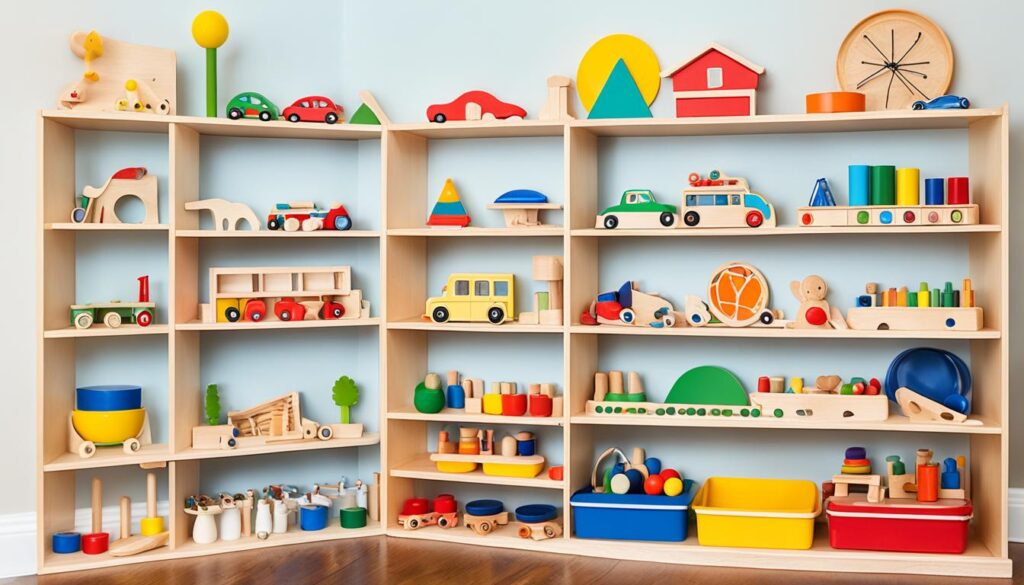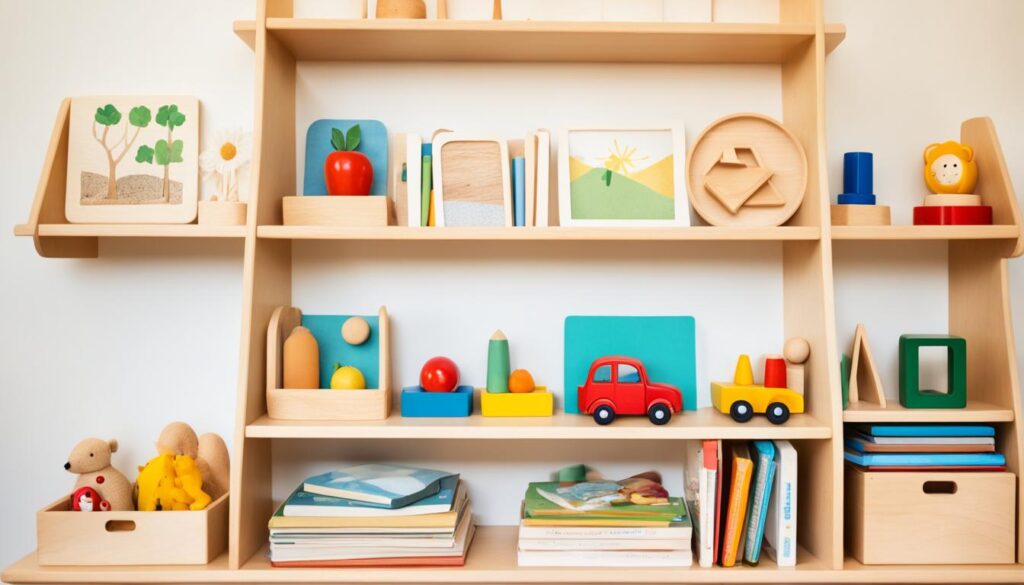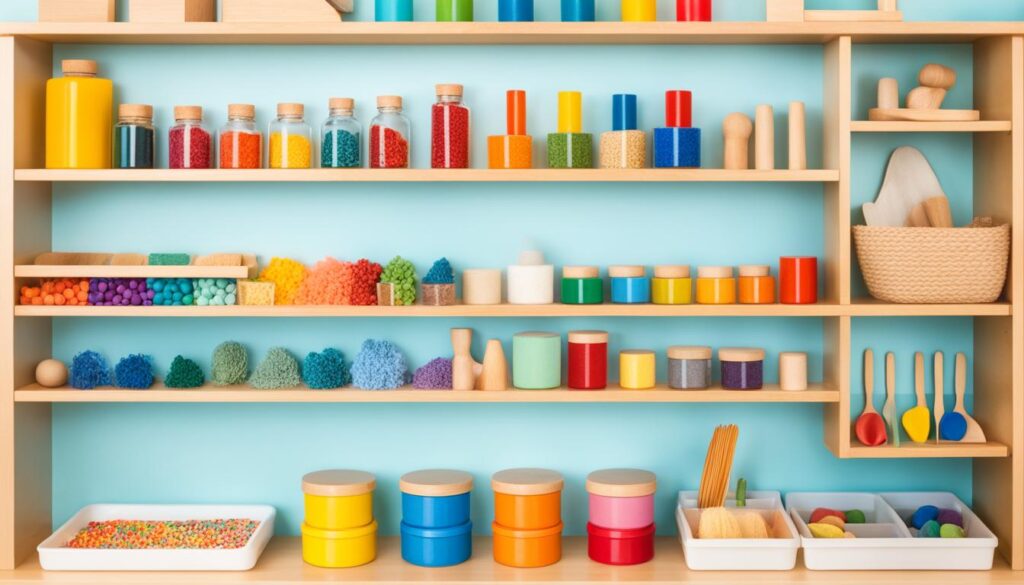Welcome to the world of Montessori education, where learning is child-centered, explorative, and engaging. One fundamental component of Montessori-inspired spaces, whether at home or in a classroom, is the Montessori shelf. These shelves are carefully designed to provide children with a variety of Montessori classroom materials, teaching tools, and learning supplies.
Montessori shelves are rooted in the principles of Montessori education, which prioritize independent play, self-motivated learning experiences, and the fostering of a child’s natural curiosity. Made from natural materials, these shelves are low, open, and easily accessible for children to select the materials that interest them the most.
By incorporating a Montessori shelf into your child’s learning environment, you create a space that encourages self-directed learning, independence, responsibility, concentration, and organization. The carefully curated Montessori learning materials and teaching tools on the shelf support your child’s growth and development in various areas, from fine motor skills to math and language exploration.
Whether you’re a parent or an educator, Montessori shelves provide a foundation for creating an environment that nurtures your child’s innate love for learning and promotes a sense of ownership and autonomy over their education.
In the following sections, we will explore the benefits of Montessori shelves for children and parents, the factors to consider when selecting the right size of Montessori shelves, the materials used in their construction, different types of Montessori shelves available, tips for setting up and organizing a Montessori shelf, and recommendations for the best Montessori shelves to suit your needs and budget. Let’s dive in!
Benefits of Montessori Shelves for Children and Parents
Montessori shelves offer a multitude of advantages for both children and parents, making them a valuable addition to any learning environment. The primary benefit is the promotion of a child’s independence and self-reliance. By providing an open and uncluttered setup, Montessori shelves empower children to confidently choose and engage in independent play, allowing them to explore their interests and make decisions on their own.
Another significant advantage of Montessori shelves is the creation of an organized learning environment. These shelves are specifically designed to display toys and materials neatly, making it easier for children to find and return items. This level of organization not only teaches children valuable life skills but also helps to instill a sense of order and responsibility.
Montessori shelves also contribute to a child’s continuous growth and development. By periodically rotating and updating the items on the shelves, children are exposed to new materials and activities. This encourages them to explore different interests, develop new skills, and foster a love for learning.
Furthermore, Montessori shelves inspire child-driven play, allowing children to fully engage in activities that interest them the most. By giving children the freedom to choose their play materials from the shelves, they are more likely to be fully engaged and motivated in their play.
Montessori shelves are not only beneficial for children but also for parents. They create a harmonious and organized atmosphere, as toys and materials are neatly displayed and easily accessible. This makes cleanup and maintenance more manageable, reducing parental stress and contributing to a more peaceful home environment.
“Montessori shelves foster independence, organization, and self-motivated learning experiences for children, while providing parents with a sense of order and simplicity.”
Ultimately, Montessori shelves play a vital role in promoting a child’s independence, concentration, and learning. They offer numerous benefits for both children and parents, creating a conducive environment for growth, exploration, and a lifelong love for learning.
Selecting the Right Size of Montessori Shelves
When it comes to choosing Montessori shelves, finding the right size is crucial for creating an optimal learning environment for your child. Consider both the height and depth of the shelf to ensure it suits your child’s age and needs.
The height of the Montessori shelf is an important factor to consider. It should be easily reachable and accessible to your child, promoting independence and preventing accidents. The ideal height varies based on your child’s age, so it’s essential to select a shelf that matches their developmental stage.
Remember, the focus is on empowering your child to explore and learn independently, so choose a height that allows them to easily reach and select materials without needing assistance.
When it comes to the depth of the shelf, it’s not as critical as the height. Most Montessori materials are within close range, so a depth of 11″ to 12″ will generally fit children of any age. This depth ensures that items on the shelf are visible and reachable for your child, while also preventing clutter and disorganization.
Prioritizing the appropriate height, depth, and safety when selecting Montessori shelves will help create a conducive learning environment for your child. By providing them with a shelf that is easily accessible, you enable them to develop independence, foster their natural curiosity, and promote a love for learning.
Materials Used in Montessori Shelves
High-quality Montessori shelves are essential for creating a safe and engaging learning environment for young children. These shelves should be sturdy and durable, ensuring no risk of tipping over. When choosing Montessori shelves, it is recommended to prioritize natural materials that promote a warm and aesthetically pleasing atmosphere.
One popular option for Montessori shelf construction is solid wood, such as pine or birch. These materials not only provide a sturdy frame but also add a touch of natural beauty to the learning space. However, if desired, plywood can also be a good alternative. While not as visually appealing, plywood can still offer durability and stability.
When designing Montessori shelves, it is important to consider the needs of children. Smooth edges and simple, uncluttered lines ensure the safety of young learners while allowing for easy access to the materials. While uncoated, unpainted, and unglued Montessori shelves are favored, the presence of these enhancements typically does not pose a risk.
Montessori shelves come in various types, including toy shelves, bookshelves, and combination shelves. Each type serves a specific purpose in a Montessori environment. By selecting the right materials and construction for Montessori shelves, you can create a space that encourages exploration, independence, and a love for learning.
Advantages of Using Natural Materials
Natural materials like solid wood provide a warm and aesthetically pleasing atmosphere in Montessori spaces, promoting a harmonious learning environment.
Considerations for Children’s Safety
- Choose sturdy materials to prevent the shelf from tipping over.
- Ensure smooth edges and simple, uncluttered lines to prevent accidents.
Types of Montessori Shelves
- Toy Shelves: Designed to store and display toys in an organized manner.
- Bookshelves: Specifically cater to displaying books for easy access and selection.
- Combination Shelves: Offer both toy and book storage options, saving space in Montessori environments.
Types of Montessori Shelves
Montessori shelves come in various types to suit the unique needs of children and their caregivers. Whether you’re looking to organize toys, books, or a combination of both, there’s a Montessori shelf perfect for your space.
Montessori Toy Shelf
A Montessori toy shelf is specifically designed to store and display children’s toys and play materials. It features bins or baskets for easy organization, allowing children to independently select toys that capture their interest and promote self-directed play. With a Montessori toy shelf, you can create an engaging and inviting play area for your child.
Montessori Bookshelf
A Montessori bookshelf is specifically crafted to showcase books in an organized manner. Its front-facing design makes it easy for children to choose books independently, fostering a love for reading and encouraging a sense of ownership over their book collection. By incorporating a Montessori bookshelf into your child’s environment, you create a space that inspires curiosity and exploration through books.
Montessori Toy and Bookshelf
For those seeking a versatile storage solution, a combination Montessori shelf is ideal. This type of shelf offers both toy and book storage options in one unit, allowing you to maximize space in Montessori-inspired environments with limited room. By combining toys and books in a single area, children have everything they need within reach to engage in self-driven play and reading.
It’s important to note that floating shelves, while visually appealing, are not typically considered Montessori. Their setup is usually at an adult height level, making them less child-friendly. For a genuine Montessori shelf experience, opt for the specifically designed Montessori toy and bookshelves.

By choosing the right type of Montessori shelf, you can create an engaging and organized space that empowers your child’s independence, curiosity, and a lifelong love for toys and books.
Setting Up Montessori Shelves
When it comes to setting up Montessori shelves, following the instructions from the manufacturer is crucial for a successful assembly. Safety should always be the top priority while putting together the shelves. Ensure that all parts are properly installed and secure to prevent accidents and ensure the durability of the shelf setup.
To enhance the functionality of Montessori shelves, consider adding trays or small containers to each shelf. This allows for easy lifting and carrying of toys or activities, enabling children to retrieve and put away items independently.
Organizing Toys and Activities
An effective Montessori shelf setup involves implementing a well-organized system for toy storage and rotation. It is important to consider the available space and make sure the number of activities displayed is proportional to it. This will prevent overcrowding and facilitate easy access to desired materials.
Organize toys and activities on the Montessori shelves based on increasing difficulty. By doing so, you can create a scaffolded learning experience for your child, allowing them to explore and build upon previous skills at their own pace.
Ensure that articles or activities are not completely hidden from view. Keep them easily reachable for your child, promoting independence and fostering their ability to make choices and engage in self-directed learning.
By maintaining an organized and engaging Montessori shelf, you provide a stimulating environment that encourages children to explore, learn, and develop valuable life skills. The carefully selected toys and activities on display foster concentration, independence, and a love for learning.
Benefits of Montessori Bookshelves
Montessori bookshelves offer numerous benefits similar to Montessori toy shelves. They promote independence, concentration, and order by providing a complete view of a child’s book collection and allowing them to choose the books they want to read. The display of book covers also encourages a love for reading at an early age. By rotating the selection of books available on the shelf, children continue to engage with literature in a meaningful way, developing their reading skills and fostering a lifelong love for books.
“A child who read books regularly tends to develop a variety of cognitive skills, including vocabulary, creativity, imagination, and critical thinking.”
Introducing Montessori bookshelves to a child’s learning environment not only encourages independent reading but also provides a sense of ownership and responsibility over their personal library. It allows children to explore various genres, topics, and authors, expanding their knowledge and appreciation for literature. Furthermore, Montessori bookshelves contribute to an atmosphere of organization and order, enabling children to easily find and return books to their designated place.
By incorporating Montessori bookshelves into a child’s space, parents and educators can create a nurturing environment that supports the development of literacy skills, fosters a lifelong love for reading, and cultivates a sense of curiosity and discovery.
Best Montessori Shelves for Children’s Spaces
When it comes to selecting the perfect Montessori shelves for your child’s space, there are plenty of options available that cater to different needs and preferences. Below are some popular recommendations that have gained recognition for their design, functionality, and ability to create an organized and engaging learning environment:
- Lovevery Montessori Shelf
- Sprout Luce Shelf
- Sapiens Child Montessori Toy Shelf
- Guidecraft EDQ Essentials Bookshelf
- ECR4Kids Birch Shelf
- IKEA Lack TV Unit (Montessori shelf hack)
These Montessori shelves are thoughtfully designed with Montessori education principles in mind, offering aesthetic appeal and functionality. Whether you’re looking for a dedicated toy shelf, bookshelf, or a combination of both, these recommendations are sure to provide a space for organized learning materials and promote independent exploration for your child.
Montessori Shelves on a Budget
Montessori shelves don’t have to break the bank to be effective. There are affordable options available that provide the same benefits of promoting independence, concentration, and order in a child’s environment. Here are a few budget-friendly alternatives:
- The Humble Crew Store bookshelf
- The Brightroom six-cube shelf
- The IKEA LACK TV Unit (Montessori shelf hack)
These options offer quality and functionality while being wallet-friendly. Don’t let a tight budget hinder you from creating a Montessori-inspired space for your child. With these affordable choices, you can still provide a stimulating and organized learning environment.

Providing a Montessori environment for your child doesn’t have to be expensive. By choosing affordable montessori toy shelves and bookshelves, you can create an engaging and organized space on a budget.
Remember, the goal is to prioritize the principles of Montessori education, such as independence and self-directed learning, rather than solely focusing on the cost of the shelves. Look for options that meet your budget constraints while providing a safe and functional learning experience for your child.
Creating an Optimal Montessori Environment with Shelves
Montessori shelves play a crucial role in creating an optimal Montessori environment. By strategically placing them in your child’s playroom or learning space, you can ensure easy access and engage your child in independent play. The organization of the shelves is key to promoting a stimulating and enriching environment for your little one.
Here are some Montessori shelf organization tips to help you create an environment that fosters exploration, learning, and the development of valuable skills:
- Limit the number of toys available on the shelf at any given time. This helps prevent overwhelm and promotes focused play.
- Organize toys based on your child’s age and difficulty level. This allows for appropriate challenges and keeps their attention engaged.
- Utilize baskets or trays for activities with multiple components. This not only keeps things organized but also encourages your child to complete tasks from start to finish.
- Ensure that toys or activities are easily visible and accessible. Avoid hiding them behind or inside other items or spaces to promote independent exploration.
By implementing these Montessori shelf organization tips, you can create an environment that encourages your child to explore, learn, and develop valuable skills at their own pace. Remember, the goal is to create an engaging and organized space that supports your child’s natural curiosity and love for independent play.
Conclusion
Montessori shelves are an essential component for creating engaging and stimulating learning spaces for children. These shelves promote independence, organization, concentration, and a love for exploration and learning. By carefully selecting the right size and materials, setting up Montessori shelves properly, and incorporating them into a child’s environment, parents and educators can provide the ideal environment for a child’s development.
Investing in high-quality Montessori shelves is a valuable investment in a child’s education and overall well-being. These shelves not only encourage independent play but also help children build important life skills such as responsibility, concentration, and organization. By creating a Montessori environment with well-organized and accessible shelves, children are empowered to explore their interests, take ownership of their learning, and develop a passion for lifelong learning.
Whether at home or in an educational setting, Montessori shelves play a pivotal role in fostering a child’s natural curiosity and promoting self-motivated learning experiences. By providing a visually appealing and accessible space for children to choose materials that interest them, Montessori shelves create an environment that encourages self-directed learning and allows children to develop at their own pace.
FAQ
What is a Montessori shelf?
A Montessori shelf is an essential component of Montessori-inspired spaces, designed to be accessible, organized, and practical, allowing children to engage in independent play and exploration.
What are the benefits of Montessori shelves for children and parents?
Montessori shelves promote a child’s independence, organization, concentration, and love for exploration and learning. They also create an organized and harmonious atmosphere for the whole family.
How do I select the right size of Montessori shelves?
The ideal height and depth of Montessori shelves vary based on the child’s age. It is crucial to choose a shelf that is easily reachable and accessible to promote independence and prevent accidents.
What materials are used in Montessori shelves?
Montessori shelves are typically made of natural materials like solid wood (pine or birch), which promote a warm and aesthetically pleasing atmosphere. Plywood is also a good option.
What types of Montessori shelves are available?
Montessori shelves come in different types, such as toy shelves, bookshelves, and combination shelves, each serving a specific purpose in a Montessori environment.
How do I set up Montessori shelves?
Montessori shelf setup involves following the manufacturer’s instructions, prioritizing safety, and organizing toys and activities based on increasing difficulty. It is important to ensure that items are easily reachable by the child.
What are the benefits of Montessori bookshelves?
Montessori bookshelves promote independence, concentration, and order by allowing children to choose the books they want to read. They also foster a love for reading at an early age.
What are some recommended Montessori shelves for children’s spaces?
Some popular recommendations for Montessori shelves include the Lovevery Montessori Shelf, Sprout Luce Shelf, and Sapiens Child Montessori Toy Shelf, among others.
Can I find affordable Montessori shelves?
Yes, there are affordable options available, such as the Humble Crew Store bookshelf and Brightroom six-cube shelf, as well as budget-friendly alternatives like IKEA’s LACK TV Unit.
How can I create an optimal Montessori environment with shelves?
To create an optimal Montessori environment, it is important to strategically place the shelves in a child’s playroom or learning space, organize toys based on the child’s age and difficulty, and ensure that toys or activities are easily accessible and not hidden or cluttered.
How can Montessori shelves benefit my child’s learning and development?
Montessori shelves promote independence, self-motivated learning, responsibility, concentration, and organization among young learners, fostering valuable life skills and a love for learning.



